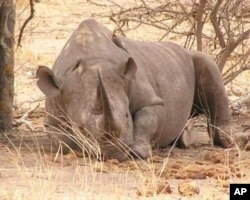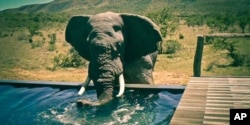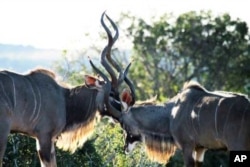This is Part 3 of a 5-part series South Africa: Reviving Endangered Wildlife
Go to Part: 1 / 2 / 3 / 4 / 5
Extinct across most of Africa where it ranged in vast numbers little more than a century ago, the black rhino is staging a remarkable comeback on the southern tip of the continent.
South African conservationists and game reserves are reestablishing herds of these animals, even as rhino come under increasing threat from poachers, who kill them for their horns. Crushed rhino horn is used in traditional medicine in the Far East, although scientists say it has no medicinal value whatsoever. Horn fragments are also used to make traditional dagger handles in the Middle East.
Environmentalists said the black rhino was once the most plentiful of all rhino species, with hundreds of thousands in Africa around 1900. But, because of hunting and poaching, in 2004 only about 2,400 remained.
Now, as a result of intensive relocation and breeding programs, the black rhino population in Africa has increased to more than 4,200, with all but a few hundred being in South Africa, according to the International Rhino Foundation.
Black rhino ‘born angry’
Angus Sholto-Douglas credits the black rhino with “inspiring” him to become a wildlife conservationist. It’s an animal that fills him with enthusiasm.
“The black rhino is the pocket-rocket of the rhino family. A big male probably weighs about a third of what a big white rhino male weighs. So he’s not as impressive a creature but his attitude makes up for it in abundance! They really are a lot of fun to be around because they’re very inquisitive and very, very aggressive. I think they’re born angry,” he told VOA.
Sholto-Douglas is the director of Kwandwe Game Reserve, in South Africa’s Eastern Cape region. About a decade ago, the park’s owners bought six black rhino, at a cost of 13.5 million rand (more than a million dollars at the time), from a reserve in KwaZulu-Natal province.
Their aim was to reestablish the black rhino in an area where the beasts had been “shot out” by hunters and poachers. “Those two bulls and four cows essentially established Kwandwe’s population. We’re just really happy that they produced so well,” said Sholto-Douglas.
The park’s original black rhino have produced several calves. Kwandwe’s successful breeding program has allowed it to “relocate excess black rhino” to other areas of the Eastern Cape “where they are more needed for conservation purposes,” Sholto-Douglas explained.
Elephants return to ancient home
The ecologically rich part of the Eastern Cape known as the “Albany Hotspot” is also the scene of the successful reestablishment of another special animal. In the 1800s, environmentalists say, the area was home to the biggest herds of elephant in Africa. But war, hunting and poaching drove the world’s largest land mammal out of the region.
Now, however, game reserves such as the Amakhala park are bringing the elephant back to their natural habitat, among the Eastern Cape’s succulent valley thicket vegetation.
Amakhala rangers and veterinarians captured 10 elephant at a drought-stricken reserve in KwaZulu-Natal. They sedated the creatures with darts fired from helicopters. “The (unconscious) elephants were crated and put onto lorries (big trucks),” explained Dr. Jennifer Gush, Amakhala’s resident zoologist. “But they can’t be kept sedated on those lorries so the (effect of) the dart is reversed and they are transported fully awake …”
Park staff members drove almost a thousand miles, through the night, to get the enormous beasts to Amakhala as quickly as possible.
“We had built a special boma, which is a small enclosure (made of wooden beams), in the middle of the reserve for (the elephants) to get used to this area. And it was also to help train them with the electric fence, because it’s the electricity running through the fence that keeps them in – not the physical strength of the fence. They were there for just over a week before they were released into the main reserve,” said Gush.
The death of George
Not long after the elephants from KwaZulu-Natal arrived at Amakhala, the reserve acquired a huge bull elephant from nearby Addo Elephant Park – the world’s largest elephant sanctuary. Park staff named him “George.”
“He was the first elephant to be trans-located out of Addo for about 50 years,” said Gush. The event received international media coverage … But it “ended badly,” the zoologist reflected. “The vets were trying a new technique of transporting (George) while he was still under the effects of the (sedative) drug rather than waking him up. But it just took too long to get him out of Addo, where they had darted him. He died as he arrived on the reserve …”
Amakhala rangers buried George in the middle of the park. Gush said the other elephants on the reserve avoided the area for six months. “That was very interesting to me, that whole social part of their make-up,” she said.
But George’s death did not deter Amakhala from expanding its elephant population. A year after the incident, it acquired two more bulls from Addo. Gush explained, “Those were transported in a traditional way – not under the effects of drugs, in a box on a lorry, and they’ve done very well here.”
‘The Ghost of Africa’
Wildlife parks in the “Albany Hotspot” are also bolstering populations of a buck indigenous to this part of South Africa. “Here in the Eastern Cape we have a unique sub-species of the kudu. It isn’t as big-bodied and big-horned as kudu elsewhere. They’ve specially adapted to the thick bush we have here,” said Iain Stewart, a conservationist whose family owns the Bucklands Game Reserve.
The kudu is the largest antelope species in Africa, and one of the biggest in the world. It has near-mythical status in South Africa. “When you see a big kudu bull, with these huge spiraling horns, it just brings about a special feeling,” said Stewart, adding, “The kudu is known as ‘the ghost of Africa’ because … there’s this brownish-grey animal with a few white stripes and a bit of a crest and a really nice chevron white between the eyes and it is so camouflaged in the bush.”
But the Eastern Cape reserves aren’t obsessed with big beasts. They’re reintroducing rare bird species, such as blue crane, kingfishers and secretary birds; a creature known as “Africa’s strangest animal” – the aardvark or “earth pig,” which uses its long snout to forage in the ground for its favorite food – ants, and small carnivorous cats such as caracal and serval.
They’re even reestablishing indigenous insects on land where they thrived centuries ago, before commercial agricultural practices decimated them. The Amakhala park, for example, is maintaining a population of endangered flightless dung beetles.
“It’s quite difficult to get them to breed in a box, in captivity, but we’re now getting reports of them almost every month,” said Gush. “So they seem to have naturally just started coming back, with the game reserve now being under natural conditions rather than farming.”













